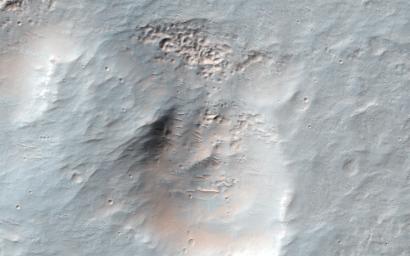
|
Icy Erosion
- Click the image above for a larger view
- Full-Res JPEG (2880 x 1800) (754.4 kB)
- Full-Res TIFF (2880 x 1800) (15.1 MB)
Caption:

Map Projected Browse Image
Click on the image for larger version
This image shows an interesting collection of kilometer-scale craters with flat and smooth floors. The craters themselves may be the result of secondary impacts, craters caused by debris from a distant larger impact. Since then, the surface has been significantly modified and reworked, muting the craters and flattening their floors.
Presently, there are a few sand dunes and a broad overlay of a dusty soil mantle. This soil mantle occurs over much of the middle latitudes of Mars. Here, as elsewhere, the mantle covers these craters, but a closer inspection reveals that its smooth texture becomes significantly pitted and bumpy on the pole facing slopes of each crater interior wall.
It has been hypothesized that this pitting of the mantle is the result of the evaporation of shallow ice. As subsurface ice is lost, the removal of this bonding ice cement allows soil grains to be eroded by the wind. Then the resulting deflation of the soil forms the observed pitted textures. Alternatively, the loss of relatively pure underground ice deposits would cause a reduction of the surface soil and collapse to form the same textures.
Background Info:
The University of Arizona, Tucson, operates HiRISE, which was built by Ball Aerospace & Technologies Corp., Boulder, Colo. NASA's Jet Propulsion Laboratory, a division of the California Institute of Technology in Pasadena, manages the Mars Reconnaissance Orbiter Project for NASA's Science Mission Directorate, Washington.
Cataloging Keywords:
| Name | Value | Additional Values |
|---|---|---|
| Target | Mars | |
| System | ||
| Target Type | Planet | |
| Mission | Mars Reconnaissance Orbiter (MRO) | |
| Instrument Host | Mars Reconnaissance Orbiter | |
| Host Type | Orbiter | |
| Instrument | High Resolution Imaging Science Experiment (HiRISE) | |
| Detector | ||
| Extra Keywords | Color, Crater, Dune, Dust, Impact, Map | |
| Acquisition Date | ||
| Release Date | 2015-12-23 | |
| Date in Caption | ||
| Image Credit | NASA/JPL-Caltech/Univ. of Arizona | |
| Source | photojournal.jpl.nasa.gov/catalog/PIA20288 | |
| Identifier | PIA20288 | |
